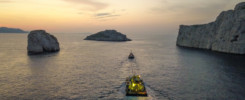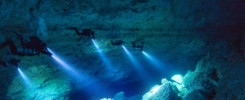Michael Menduno of Global Underwater Explorers has done a lot of in-depth work over the past 6 months resulting in an excellent 15-page article in InDepth magazine.
This article is the outcome of a long exchange process between Michael Menduno and Azoth Systems’ Team. It reviews both how the bubble detection through the O’Dive technology works, as well as the app operation and what benefits it can bring to divers.
You will also find numerous feedback from diving professionals: Pr. Costantino Balestra (DAN Europe), Frauke Tillmans (DAN US), Christian Heylen (IANTD), Paul Toomer (RAID), Phil Short, Edd Stockdale…
To address the questions and remarks raised here and there by this article, we have written an explanatory text that sets out the exact contours of the use of O’Dive technology. We hope you enjoy reading it!
O'Dive in a nutshell - understanding O'Dive
- Introduction
O’Dive is a system that couples statistical decompression analysis with Doppler ultrasound bubble detection aiming at progressively improving the quality of your decompression procedures.
O’Dive’s premise relies on the calculation of a quality index (QI) of your decompression procedure after each dive, comparatively to a population (database).
O’Dive is not a single-use tool: its benefits will come from a periodic use, by allowing you to know the effects of your procedures in terms of vascular bubbles production and giving you the possibility to evolve these procedures to lower your bubbles scores levels.
- How does it work?
– After each dive, O’Dive will calculate a quality index of your decompression: QI.
This Quality Index is determined from a pDCS risk calculation involving two informations that can be quantified and measured: the dive profile and the post-dive bubble score.
But even though it involves a pDCS risk calculation, QI is nevertheless not considered as a risk estimation in the app, as it is calculated considering “only” two categories of parameters (dive profile & bubbles scores).
That’s also why its name is not “Risk estimation” – which would need to involve a lot of other parameters (most of them being perfectly unquantifiable as sleep quality, training, tiredness etc…) – but “Quality Index of your decompression”.
However, it can be pointed out that many factors that increase the risk of DCS are also increasing the bubbles formation.
This Quality Index, even if it has some limitations in terms of individual risk estimation is nevertheless a very interesting piece of information. Why?
- Interest of the Quality Index
Its major interest is to bring a comparison basis from which it is possible to compare the performance of two different dive procedures or two dive practices, and then target an improvement relatively to this QI. The question is therefore not whether the Quality Index is perfectly reflecting the pDCS risk encountered by a diver on a single dive. The point is to know if the Quality Index is an indicator consistent enough from which it is possible to build real progress.
> If – relatively to the figures and to the scientists consensus detailed in the following paragraph “The science behind the tool” – we consider that it is an effective improvement to be able to switch in only a few dives from a practice that was generating all the time high levels of bubbles (grade 4 for instance) to a dive practice that generates only low bubbles scores (grade 1 or 0, or ideally 0 all the time) and to keep the diver in this target over time, then the answer is yes.
> If we consider that it is a progress to have access to a personalized simulation considering your own bubbling dynamic – qualified dive after dive against a database of thousands of dives and observed bubble dynamics – to help the planification of next dive in order to lower bubbles scores, then the answer is yes again.
- The science behind the tool
O’Dive is primarily based on the high “Negative Predictive Value” (NPV) of vascular bubbles regarding DCS occurrence. This figure which makes a consensus in the scientists community is representative of the fact that a score of “zero” or no bubble after the dive is a good target in terms of safety.
In a peer-reviewed article published with DRDC (Defence Research and Development Canada) scientists based on dive profiles and related bubbles data collected over a period of 40 years, it has been shown that for a similar dive profile, air divers that were having high bubble grades were 5 to 17 times more frequently involved in DCS incidents than divers having no bubble or low bubble grades.
At the scale of just one single dive, as DCS are infrequent events, there is a global consensus between scientists to say that “bubbles do not equal DCS”.
This reality is reflected by a poor Positive Predictive Value (PPV) of vascular bubbles regarding DCS occurrence. It means that bubbles can be detected without any DCS symptom in numerous cases.
In summary, when considering one single dive: having post dive bubbles does not mean at all that a DCS will occur but having no post-dive bubble is a good indicator of safety.
And at the scale of a whole life of diving, when considering the cumulative effect of additional risks, lowering or avoiding bubbles may bring a significant safety factor.
It is precisely in this perspective that O’Dive positions itself: to improve safety continuously and in the long term.
- Azoth Systems’ vision
Azoth Systems tools are the result of more than ten years of research, involving 4 PhD theses, the analysis of thousands of dive profiles with relative DCS and the development of a technology unic in the world.
O’Dive is giving the diver a way of knowing himself, his own physiology and decompression with respect to others: “Am I producing more bubbles, diving less conservative than others?”
The simulation tool is suggesting levers that all go in the sense of increasing the conservatism of dives, and offers the diver a possibility to act to be more on a safe side.
In brief, O’Dive’s purpose is to help divers adapt the way they dive in order to lower their bubble scores and ideally bring it to zero. Through this, much more safety is expected compared to a previous situation with a lot of bubbles, especially when considering a cumulative effect over the long term.
Azoth Systems will welcome any expert or initiative which motivation is focussing on enhancing diving safety. Feel free to contact us!
Analogy between diving and driving
An analogy with driving at high or low speed (Versus making more or less conservative dives) and being more or less tired (producing more or less bubbles) can be done to illustrate our vision.
If you drive at a high speed being tired, well, you are at risk. If you dive deep and non-conservatively and always produce lots of bubbles after your dive, well, you are at risk also.
As simple as that: maybe you get in an accident, maybe not, but you are not on the safe side.
Sure, there are lots of other factors putting you in danger in driving despites the speed and the tiredness… There are lots of other factors in diving despites dive conservatism and the circulating bubbles: PFO, hydration, stress, water temperature, physical form, effort and so on…
It would be nice to control for all of those, but while waiting let’s at least control the profile and the bubbles.
O’Dive take off message?
“Be on a safe side, keep your dive conservatism and bubbles production under control.”

MIKE MENDUNO
Editor in chief for INDEPTH
Michael Menduno is an award-winning reporter and technologist who has written about diving and diving technology for 30 years. He coined the term “technical diving.” His magazine “aquaCORPS: The Journal for Technical Diving”(1990-1996) helped usher tech diving into mainstream sports diving. He also produced the first Tek, EUROTek and ASIATek conferences, and organized Rebreather Forums 1.0 and 2.0. Michael received the OZTEK Media Excellence Award in 2011, the EUROTek Lifetime Achievement Award in 2012 and the TEKDive USA Media Award in 2018.



